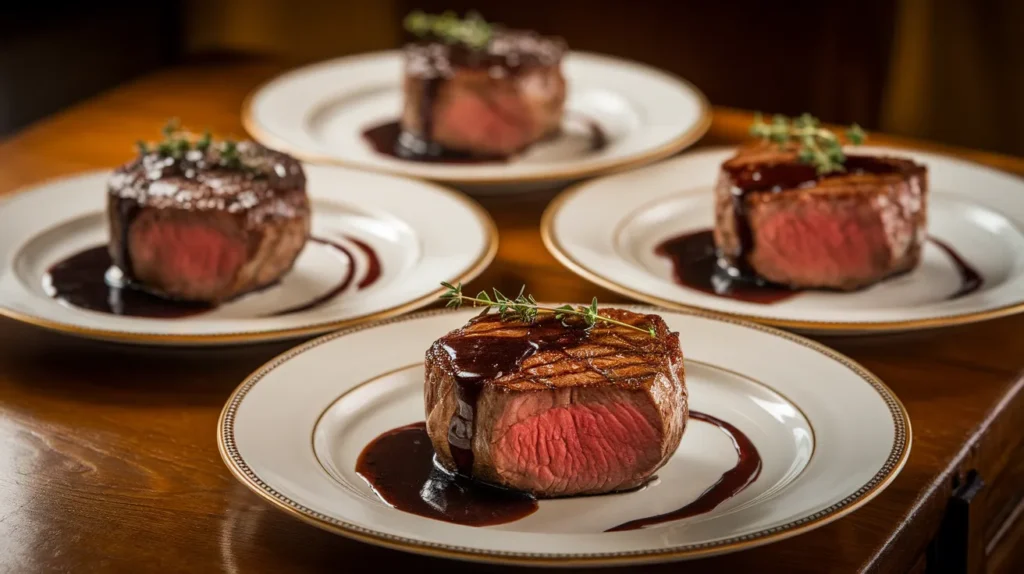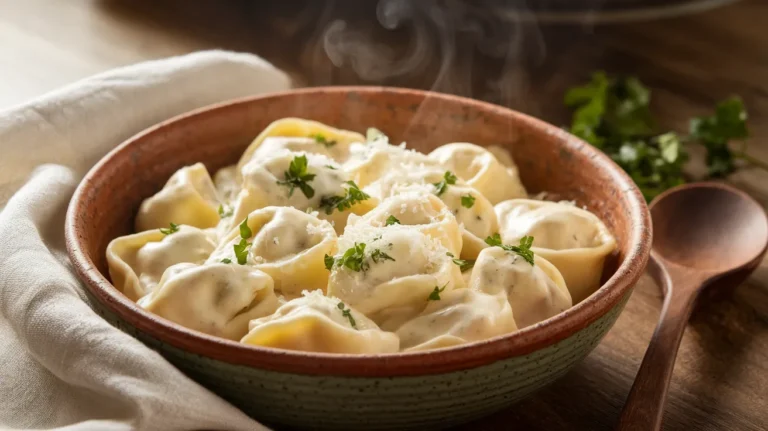Transform your filet mignon into a restaurant-quality masterpiece with this foolproof sauce for filet mignon recipe. This rich, velvety red wine pan sauce combines butter, shallots, and fresh herbs to create the ultimate sauce for filet mignon that even beginners can master with confidence.
Recipe Info Bar
SERVES: 4 | PREP: 15 MIN | COOK: 25 MIN | TOTAL: 40 MIN
Ingredients
For the Sauce for Filet Mignon
| Ingredient | Amount | Notes |
|---|---|---|
| Red wine | 1 cup | Cabernet Sauvignon or Merlot |
| Beef stock | ½ cup | Low-sodium preferred |
| Shallots | 2 medium | About ¼ cup when minced |
| Butter | 4 tablespoons | Cold, cut into small cubes |
| Fresh thyme | 2 sprigs | Or 1 tsp dried thyme |
| Garlic | 2 cloves | Finely minced |
| Heavy cream | 2 tablespoons | Optional for extra richness |
| Salt | ½ teaspoon | Kosher salt preferred |
| Black pepper | ¼ teaspoon | Freshly ground |
For the Filet Mignon Steaks
| Ingredient | Amount | Notes |
|---|---|---|
| Filet mignon steaks | 4 pieces (6 oz each) | 1½ inches thick |
| Olive oil | 2 tablespoons | Or vegetable oil |
| Salt | 1 teaspoon | Coarse kosher salt |
| Black pepper | ½ teaspoon | Freshly cracked |
Step-by-Step Instructions for Sauce for Filet Mignon
Phase 1: Preparing Everything (10 minutes)
- Remove steaks from refrigerator 30-45 minutes before cooking
- Take steaks out of packaging and place on a clean plate
- Cover loosely with plastic wrap to prevent drying
- Room temperature steaks cook more evenly and prevent overcooking the outside while the inside stays cold
- Set a timer so you don’t forget this crucial step
- Prepare all your ingredients (mise en place)
- Mince 2 shallots very finely – they should be about the size of rice grains
- Mince 2 garlic cloves until they’re almost paste-like
- Strip thyme leaves from stems and roughly chop
- Cut cold butter into small cubes (about ½-inch pieces) and keep in refrigerator until needed
- Measure out wine and beef stock in separate containers
- Pat steaks completely dry with paper towels
- Use 3-4 paper towels per steak if needed
- Press firmly to remove all surface moisture
- Wet steaks won’t sear properly and will steam instead of browning
- The steaks should feel tacky to the touch when properly dried
- Season steaks generously on both sides
- Sprinkle salt evenly over both sides, using about ¼ teaspoon per side
- Add freshly cracked black pepper
- Gently press seasonings into the meat with your palms
- Let seasoned steaks sit for 10 minutes to allow salt to penetrate
Phase 2: Searing the Perfect Filet Mignon (10 minutes)
- Heat your pan over medium-high heat for 2-3 minutes
- Use a heavy-bottomed pan (cast iron or stainless steel work best)
- The pan is ready when a drop of water sizzles and evaporates immediately
- Don’t use non-stick pans – they won’t create the fond (browned bits) needed for sauce
- Add oil to the hot pan
- Pour oil around the edges, not directly in the center
- Swirl pan to coat the bottom evenly
- The oil should shimmer but not smoke
- If oil starts smoking, remove pan from heat for 30 seconds
- Carefully place steaks in the hot pan
- Lay steaks away from you to prevent oil splatter
- Don’t overcrowd – leave at least 1 inch between steaks
- You should hear an immediate loud sizzle
- If there’s no sizzle, the pan isn’t hot enough
- Sear first side for 3-4 minutes without moving
- Resist the urge to peek or move the steaks
- The steaks will naturally release when properly seared
- Look for golden-brown edges to form around the bottom
- This creates the delicious fond that makes our sauce for filet mignon so flavorful
- Flip steaks once using tongs
- Don’t use a fork (it pierces the meat and releases juices)
- Steaks should lift easily when ready to flip
- The seared side should be golden-brown and caramelized
- If steak sticks, wait another minute before trying again
- Cook second side for 3-4 minutes for medium-rare
- For medium-rare: internal temperature of 130-135°F
- For medium: cook additional 1-2 minutes (140°F internal temp)
- Use a meat thermometer inserted into the thickest part
- Remember, temperature will rise 5°F during resting
- Remove steaks and let them rest
- Transfer to a warm plate or cutting board
- Tent loosely with aluminum foil (don’t wrap tightly)
- Let rest for 5-10 minutes while making sauce
- Resting redistributes juices for maximum tenderness
Phase 3: Creating the Ultimate Sauce for Filet Mignon (15 minutes)
- Reduce heat to medium and examine the pan
- Look at those beautiful brown bits (fond) on the bottom
- These caramelized drippings are the foundation of great sauce for filet mignon
- If pan looks dry, add a tiny bit of oil
- If pan seems too hot, let it cool for 1 minute
- Add minced shallots to the same pan
- Sprinkle shallots evenly across the pan bottom
- They should sizzle gently, not aggressively
- If they’re browning too fast, reduce heat to medium-low
- Stir constantly with a wooden spoon to prevent burning
- Cook shallots for 2-3 minutes until fragrant
- Shallots should become translucent and soft
- You’ll smell a sweet, aromatic fragrance
- Use wooden spoon to scrape up any browned bits while stirring
- Don’t let shallots turn brown or they’ll become bitter
- Add minced garlic and thyme
- Stir constantly for 30-45 seconds
- Garlic should become fragrant but not brown
- Fresh thyme leaves will release their oils quickly
- If mixture starts to brown, remove pan from heat briefly
- Pour in red wine very carefully
- Stand back slightly as wine will create steam and splatter
- Pour wine slowly to prevent dangerous flare-ups
- The mixture will bubble and hiss dramatically – this is normal
- Immediately start scraping the bottom with wooden spoon
- Scrape up all the fond (browned bits)
- Use wooden spoon to scrape every bit of caramelized goodness
- These bits dissolve into the wine and create incredible flavor
- Don’t worry if some pieces seem stubborn – they’ll dissolve as wine simmers
- This step is crucial for the best sauce for filet mignon
- Simmer wine mixture for 6-8 minutes
- Wine should bubble gently, not violently boil
- Stir occasionally to prevent sticking
- Wine will reduce by about half and become syrupy
- You’ll smell the alcohol cooking off – this is important
- Add beef stock and continue simmering
- Pour stock slowly while stirring
- Mixture will bubble up briefly, then settle
- Simmer for 4-5 minutes until total liquid reduces to about ⅓ cup
- Sauce should coat the back of a spoon lightly
- Remove pan from heat completely
- This step is crucial – hot pan will cause butter to separate
- Let sauce stop bubbling completely
- Have your cold butter cubes ready
- Work quickly but don’t panic during next steps
- Whisk in cold butter one piece at a time
- Add one butter cube and whisk vigorously until mostly melted
- Add next cube and repeat process
- Each addition should be almost melted before adding the next
- This creates a smooth, glossy emulsion that’s the hallmark of great sauce for filet mignon
- Stir in cream (if using) and season to taste
- Add cream slowly while whisking
- Taste sauce with a clean spoon
- Add salt gradually – start with ¼ teaspoon
- Add pepper to taste – sauce should have balanced flavors
- Strain sauce for restaurant-quality smoothness
- Pour sauce through fine-mesh strainer into clean bowl
- Press solids gently with spoon to extract all liquid
- Discard solids – you now have silky smooth sauce for filet mignon
- Keep sauce warm (not hot) until ready to serve
- Serve immediately over rested filet mignon
- Spoon 2-3 tablespoons of warm sauce over each steak
- Serve remaining sauce on the side
- Garnish with fresh thyme sprigs if desired
- Enjoy your restaurant-quality sauce for filet mignon!
Chef’s Notes for Perfect Sauce for Filet Mignon
• Choose quality wine – Use a wine you’d drink. The flavors concentrate during reduction, so mediocre wine creates mediocre sauce for filet mignon.
• Temperature control is everything – Hot pan breaks butter emulsion, while cold pan won’t properly reduce wine.
• Don’t rush the process – Each step builds flavor layers that create the perfect sauce for filet mignon.
• Save some fond – This technique works beautifully with other beef cuts like tenderloin when you want variety.
Nutrition Information (Per Serving)
- Calories: 445
- Protein: 36g
- Carbohydrates: 4g
- Fat: 30g
- Sodium: 420mg
Creative Variations for Sauce for Filet Mignon
1. Mushroom-Enhanced Red Wine Sauce
Add 8 oz sliced cremini mushrooms with the shallots. Cook until golden for an earthy twist on classic sauce for filet mignon.
2. Fresh Herb Garden Sauce
Fold in chopped fresh rosemary, parsley, and chives at the end for a bright, garden-fresh sauce for filet mignon.
3. Cognac Flambé Sauce
Replace wine with cognac and carefully flambé for dramatic presentation and deeper, more complex flavors.
4. Lighter White Wine Version
Use white wine instead of red for a more delicate sauce. This technique also adapts well for other meat dishes when modified appropriately.
Storage & Reheating Your Sauce for Filet Mignon
Refrigerator Storage: Store leftover sauce in airtight container for up to 4 days.
Proper Reheating: Warm gently in small saucepan over lowest heat setting, whisking constantly. Add splash of stock if sauce thickens too much.
Make-Ahead Strategy: Prepare through step 19 up to 4 hours ahead. Finish with butter just before serving for best texture.
Freezer Note: This sauce for filet mignon doesn’t freeze well due to dairy content.

Troubleshooting Your Sauce for Filet Mignon
Problem: Sauce is too thin and won’t coat spoon Solution: Return to medium heat and simmer 2-3 minutes longer. Whisk in extra tablespoon of cold butter off heat.
Problem: Sauce broke and looks greasy
Solution: Remove from heat immediately. Whisk in 1-2 tablespoons cold stock vigorously to re-emulsify the sauce for filet mignon.
Problem: Wine flavor overwhelms other tastes Solution: Add pinch of sugar and extra beef stock to balance acidity. Simmer 1 minute longer to mellow flavors.
Problem: Steaks overcooked while making sauce Solution: Use meat thermometer next time. Remove steaks 5°F before target temperature since they continue cooking while resting.
Problem: No fond formed during searing Solution: Ensure steaks are bone dry before searing. Use higher heat and don’t move steaks during initial searing.
Equipment Essentials
• Heavy-bottomed skillet (10-12 inch cast iron or stainless steel) • Fine-mesh strainer for silky smooth sauce texture • Instant-read thermometer for perfect steak doneness • Small whisk for emulsifying butter smoothly • Sharp knife for mincing aromatics • Wooden spoon for scraping fond without scratching pan
Shopping List for Sauce for Filet Mignon
Meat Counter
- 4 filet mignon steaks (6 oz each, 1½ inches thick)
Dairy Section
- Heavy cream (small container)
- Unsalted butter (1 stick needed)
Produce Section
- Shallots (2 medium)
- Fresh garlic (1 head)
- Fresh thyme (small package)
Wine/Pantry Section
- Red wine (Cabernet Sauvignon or Merlot)
- Low-sodium beef stock
- Extra virgin olive oil
- Kosher salt
- Whole black peppercorns
Success Secrets for Perfect Sauce for Filet Mignon
- Room temperature steaks prevent overcooking – This 30-45 minute wait ensures even cooking from edge to center.
- Dry steaks create better fond – Moisture prevents proper browning and reduces flavor development for your sauce for filet mignon.
- Cold butter creates restaurant-quality finish – Adding butter off heat prevents breaking and creates glossy emulsion.
- Taste and adjust throughout process – Great sauce for filet mignon requires balancing salt, acid, and richness to perfection.
- Serve immediately for best results – This sauce for filet mignon tastes incredible when warm and freshly prepared.
Master this detailed technique and you’ll create the perfect sauce for filet mignon that transforms any dinner into an elegant restaurant experience. The rich, velvety texture and deep wine flavors prove that restaurant-quality sauce for filet mignon is absolutely achievable in your home kitchen.




